2020 MV Agusta Superveloce Review

Motorcycle art doesn't always translate.
Motorcycle art. MV Agusta’s tagline for years, if there’s one thing the Italian company is known for, it’s pumping out motorcycles that never fail to grab your attention. And while the Tamburini-designed F4 still ranks as one of the most stunning motorcycles ever made, I’m going to rank this, the MV Agusta Superveloce, as the first MV since the F4 to even come close to capturing hearts the same way.
2020 MV Agusta Superveloce 800
| Engine | 17.0/20 |
| Suspension/Handling | 13.0/15 |
| Transmission/Clutch | 8.5/10 |
| Brakes | 7.5/10 |
| Instruments/Controls | 5.0/5 |
| Ergonomics/Comfort | 6.0/10 |
| Appearance/Quality | 10.0/10 |
| Desirability | 10.0/10 |
| Value | 5.0/10 |
| Overall Score | 82/100 |
Unlike the F4, however, which was basically a clean-sheet design Tamburini had nearly free rein to do what he wanted with, the Superveloce essentially takes the bones from the existing F3 800 and repurposes it. In that regard, MV Agusta design director Adrian Morton deserves some credit, as recreating an existing model – with the deadlines and politics surrounding modern corporations – into something this beautiful is no easy feat.
So, let’s take a closer look at the MV Agusta Superveloce. We’ll talk about what it is, what it isn’t, and what it’s like to ride. You’re forgiven if you skip a few words because you were looking at the pictures here instead. But I encourage you to pay attention. My final thoughts on this bike may not be what you think.
A Rich Heritage
Motorcycle gearheads will recognize the Superveloce and instantly be reminded of an era gone by. If you’re one of those people who can relate, you’re probably looking at the Superveloce as a modern interpretation of old grand prix bikes – and that’s exactly the point.
Even if you’re not as familiar with MV’s past, if you dig the looks of the Superveloce, then you’re about to get a crash course in why it looks the way it does. Morton and his team took inspiration for the Super-V from MV’s own grand prix racers from the 1960s and 1970s, before the company dropped out of grand prix racing in 1976.
As your eye gazes along, the folds and creases that make up the fuel tank and tail section admittedly look thoroughly modern (some might even say complex), though the leather belt strap atop the tank is a blatant homage to the past. You know, when fuel tanks were actually held on with leather straps. Whether it fits in this context I’ll leave for you to decide.
The MV gets back in line with its heritage when we reach the back of the bike. The slim tail section can’t be ignored. Proportionately, it’s clear the inspiration came from racers of the past. It’s so diminutive, and yet it ties the bike together nicely. The single round LED taillight, like the headlight in front, is simple. And that’s what makes the whole thing work. Visually, it isn’t weighed down by having to carry turn signals and a license plate – those are mounted separately on an arm attached to the swingarm to give a “floating” appearance.
Together, the Superveloce is nothing short of stunning. This is how you style a modern sportbike with a flair for the past.
What’s Inside?
As was mentioned before, the Superveloce is basically an F3 800 with different clothes. Some might be disappointed that MV didn’t start with a fresh sheet of paper for this one, but for pragmatic (and financial) reasons, it should be obvious why MV chose the path it did.
Still, the 798cc Triple is one sweet engine. With 12 valves, six injectors, 13.3:1 compression, a counter-rotating crankshaft, and an oversquare bore and stroke (79 mm x 54.3 mm), MV says it pumps out 148 horses (at the crank) at 13,000 rpm – that’s healthy. Full ride-by-wire means you also get traction control (adjustable to eight levels, and off), four ride modes, and cruise control(!). You also get other electronic goodies like Continental ABS, and a quickshifter in both directions.
On the suspension side, we see a 43mm Marzocchi inverted fork with rebound, compression, and spring preload adjustment. A Sachs shock is in the rear with the same level of adjustment. Dual 320mm discs are paired with Brembo M4.34 radial-mount calipers, with a single 220mm disc and Brembo 2-piston caliper in the back.
If this sounds awfully similar to the F3 800, that’s because it is.
Riding It
Of course, looking at a motorcycle is one thing. Actually riding it is where it counts. With a name like Superveloce, this is a bike that likes to be ridden super fast. Naturally, I was happy to oblige. With a trip out to the race track, the MV is in its happy place. This makes sense considering its grand prix inspiration (though I’ll stop short of calling it “heritage”).
When all 148 horses are galloping at full tilt and the three-cylinder is wailing, the Super-V moves along at a quick pace – but not a frightening one like a 200 hp literbike would deliver. It’s fun and manageable, made even better by the clean, linear fueling and throttle mapping. Each twist of the wrist is met with an appropriate amount of thrust. Kudos to MV, because it wasn’t long ago when I couldn’t say such a thing about MVs…
Speaking of mapping, keeping the bike in its most aggressive Race ride mode wasn’t intimidating. Again, the clean fueling does wonders here. And considering the perfect riding conditions, there was no need to drop to a different mode. Not that you’d really need to. The quickshifter is a godsend as long as you’re deliberate with each shift. Linger with your foot around the shifter and you could be met with an accidental ignition cut. So, either use the shifter or keep your foot back on the peg.
With the underpinnings of the F3 800, the Superveloce’s manners through a corner are sweet. It tips into a corner with ease, on or off the brakes, which is likely helped by the counter-rotating crank. Once leaned over it holds its line and reacts to inputs nicely. This really is a sweet little track bike.
Well, almost.
On the track there were three glaring issues that kept bothering me. First is the lack of room. While yes, the slim tail section is visually appealing and attractive, in practical terms the small seat doesn’t give the rider much room to scoot back in a tuck. So even at 5-foot, 8-inches, I couldn’t get comfortable on it. Not a huge deal on a tighter track, but anywhere with a long straight, this could get annoying pretty quickly.
Second, the brakes. While I’d prefer a little more feel and linearity at the initial application of the brakes, there’s actually plenty of stopping power. And that’s the problem. On track the ABS intervenes much sooner than it needs to, which then leads to a pulsing lever, and you left wondering if you’re going to make the corner or not. To make matters worse, ABS is always on. It’s adjustable, but even in its least intrusive setting it kicks in far earlier than is needed.
The third is traction control. This complaint isn’t so much about what it is, but more about what it isn’t. The 2020 Superveloce doesn’t have an IMU, so it’s old-school, which may or may not fit the old-grand-prix-racer theme. The reactive system (as opposed to predictive) actually works as well as a reactive system can. But it’s the unfortunate reality that modern sportbikes are now judged by the robustness of their electronics, and this one falls short.
UPDATE: Well, this is awkward. As I sit here typing this review of the 2020 MV Agusta Superveloce, just yesterday MV announced an updated version of the Super-V for 2021, complete with a big addition I wish the current model came with – an IMU.
On the street, the Superveloce finds itself in an awkward position. It thrives when it’s being revved and the sweet motor is singing. Get it up in the hills and you’ll enjoy hearing the unique three-cylinder wail bounce off the canyon walls. All the attributes that make the bike a nice handler on track transfer over to the street, too, and being able to adjust the suspension for the rougher environs of publicly maintained roads is obviously a benefit. What’s more, the generally slower pace of a canyon ride means the ABS intervention isn’t much of an issue.
Obviously, there’s a “but.” The MV’s sweet spot is very narrow. Normal riding brings out other flaws. First, there’s the hard seat. Other than the addition of the IMU in the 2021 update, MV also added more seat foam, though we can’t imagine it’ll make a drastic difference. On our 2020 tester anyway, the seat was very hard, making a trip to Starbucks about as far as we wanted to go at any one time. To make matters worse, the creases from the body panel beside the seat pad bend at a sharp angle, which just so happens to be right where the rider’s thighs are. So not only is the seat hard, but you have hard plastic biting into you as you’re rolling down the road.
Next is the engine. It clearly likes to rev. So when it’s not, the ride suffers. Cruising along at about 5500 rpm, the bars emit this medium-frequency vibration that slowly creeps in and makes your hands fall asleep. Luckily, a dab of the cruise control will let you shake your hands free (assuming it’s safe to do so, of course!) There’s a decent amount of torque even when you’re down that low in the rpm range, but the Triple isn’t as eager to spring into action until the revs pick up.
As fun as it is to keep the engine singing and move the bike from side to side, that’s only a small part of most street rides. The rest of the time you’re headed in a mostly straight line with the engine in an efficient (read not screaming) zone. Here, the Superveloce’s hard seat, sharp creases, and hyper engine loses some of its appeal.
Beauty Is In The Eye Of The Beholder
Sometimes you give up something in the name of beauty and vanity. The Superveloce, while no doubt a head-turner, will require some dedication if you actually plan to ride it. Of course, if this is an object of your desire, you might be willing to make those concessions for the trade-off it gives you each time you stare at it. I am not one of those people.
The addition of an IMU for 2021 will certainly go a long way towards addressing the effectiveness and modernity of the bike’s electronics package, but a little more seat foam likely won’t do much to improve comfort. Nor does it add any more space to scoot back. But if you’re one who loves the looks (who doesn’t?), and is willing to wring the bike’s neck, you’re sure to get a thrill ride.
2020 MV Agusta Superveloce
+ Highs
- Stunning looks
- The engine’s a ripper!
- Impressive handling
– Sighs
- That seat is pretty hard
- Doesn’t appreciate going slow
- Electronics a bit outdated (but hopefully fixed for 2021!)
In Gear

Helmet: Arai Defiant-X Dragon $810
- Jacket: Alpinestars Bomber Jacket $250
- Airbag: Alpinestars Tech-Air 5 $700
- Pants: Alpinestars Crank Riding Denim DISCONTINUED
- Gloves: Alpinestars SP-2 v2 Gloves $140
Boots: Alpinestars Faster 3 Rideknit Shoes $180
2020 MV Agusta Superveloce Specifications | |
|---|---|
| Engine Type | Three cylinder, 4 stroke, 12 valve |
| Timing system | DOHC with mechanical chain tensioner |
| Displacement | 798 cc |
| Compression Ratio | 13.3:1 |
| Starting | Electric |
| Bore x stroke | 79 mm x 54.3 mm |
| Horsepower | 148 hp at 13000 rpm (claimed) |
| Torque | 64.9 lb.ft. at 10600 rpm (claimed) |
| Cooling system | Cooling with separated liquid and oil radiators. |
| Engine Management | Integrated ignition – injection system MVICS (Motor & Vehicle Integrated Control System) with six injectors Engine control unit Eldor EM2.0, throttle body full ride by wire Mikuni, pencil-coil with ion-sensing technology, control of detonation and misfire Torque control with four maps, Traction Control with eight levels of intervention |
| Electronic Quickshift | MV EAS 2.1 (Electronically Assisted Shift Up & Down) |
| Clutch | Wet, multi-disc slipper clutch |
| Transmission | Cassette style; six speed, constant mesh |
| Frame | ALS Steel tubular trellis, aluminum swingarm pivot plates |
| Front Suspension | Marzocchi 43mm inverted telescopic hydraulic fork with rebound-compression damping and spring preload external and separate adjustment; 4.92 inches of travel |
| Rear Suspension | Progressive Sachs, single shock absorber with rebound and compression damping and spring preload adjustment; 4.84 inches of travel |
| Front Brake | Double floating disc with Ø 320 mm (Ø 12.6 in.) diameter, with steel braking disc and flange, Brembo radial-type monobloc, with 4 pistons Ø 34 mm |
| Rear Brake | Single steel disc with Ø 220 mm (Ø 8.66 in.) dia., Brembo with 2 pistons – Ø 34 mm |
| ABS System | Bosch 9 Plus with Race Mode and RLM (Rear wheel Lift-up Mitigation) |
| Front Wheel | Aluminum alloy 3.50 ” x 17 ” |
| Rear Wheel | Aluminum alloy 5.50 ” x 17 ” |
| Front Tire | 120/70 – ZR 17 M/C (58 W) Pirelli Diablo Rosso Corsa II |
| Rear Tire | 180/55 – ZR 17 M/C (73 W) Pirelli Diablo Rosso Corsa II |
| Fairing Material | Thermoplastic |
| Wheelbase | 54.33 inches |
| Overall Length | 79.92 inches |
| Overall Width | 28.74 inches |
| Saddle Height | 32.68 inches |
| Ground Clearance | 4.72 inches |
| Trail | 3.89 inches |
| Dry Weight | 381.4 lbs. (claimed) |
| Fuel Capacity | 4.36 gallons |
| Other Features | Exclusive content: Dashboard TFT 5” color display – Cruise control – Bluetooth – GPS – App MVride for navigation mirroring, app-controlled engine, rider aids setup – Fuel Cap (with leather strap). |
We are committed to finding, researching, and recommending the best products. We earn commissions from purchases you make using the retail links in our product reviews. Learn more about how this works.
Become a Motorcycle.com insider. Get the latest motorcycle news first by subscribing to our newsletter here.

Troy's been riding motorcycles and writing about them since 2006, getting his start at Rider Magazine. From there, he moved to Sport Rider Magazine before finally landing at Motorcycle.com in 2011. A lifelong gearhead who didn't fully immerse himself in motorcycles until his teenage years, Troy's interests have always been in technology, performance, and going fast. Naturally, racing was the perfect avenue to combine all three. Troy has been racing nearly as long as he's been riding and has competed at the AMA national level. He's also won multiple club races throughout the country, culminating in a Utah Sport Bike Association championship in 2011. He has been invited as a guest instructor for the Yamaha Champions Riding School, and when he's not out riding, he's either wrenching on bikes or watching MotoGP.
More by Troy Siahaan








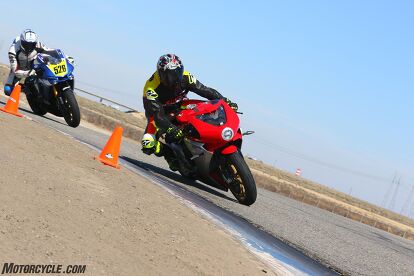





















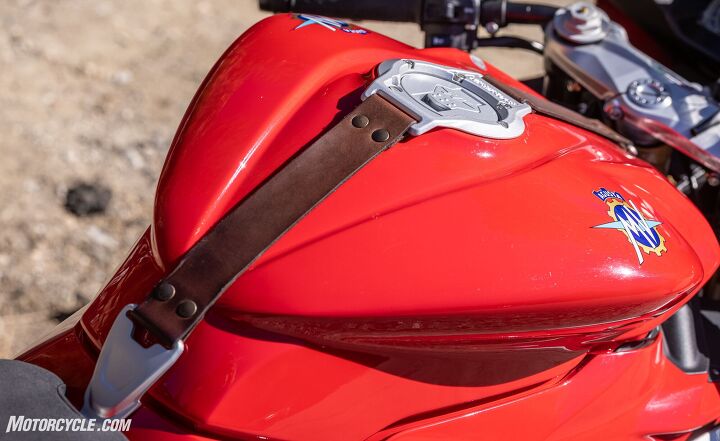





















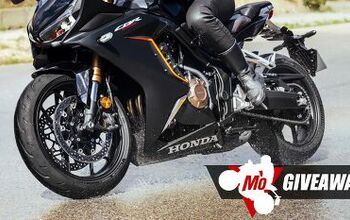

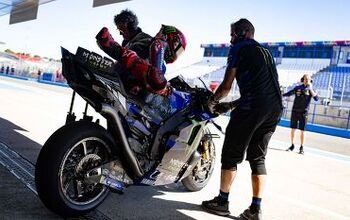


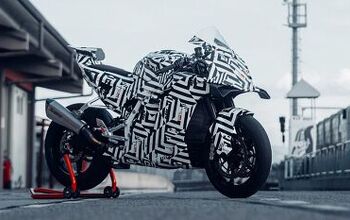






Comments
Join the conversation
This sounds like it could have been a fantastic and reasonably accommodating for mortal human riders track day bike for those who want something unique and are willing to spend the money. The utter lack of practicality off the track, and even while on it due to the hard seat and cramped tail truly is unfortunate.
Dork. This kid has no idea. Honda must love him